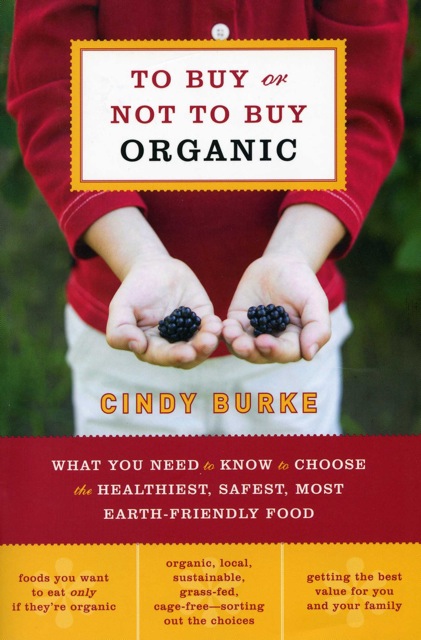
reference-image, l
(article, Caroline Cummins)
[%pageBreakSettings nobreak=true][%adInjectionSettings noInject=true] A former chef, the Seattle-based Cindy Burke contributed recipes to 2003's [%bookLink code=1580085431 "The Trans Fat Solution"], written by New York Times staffer Kim Severson. Now she has a book of her own: To Buy or Not to Buy Organic, a slim, handy guide to how our food is produced and how to choose what to buy. "We all want to make food choices that improve our quality of life," Burke writes in her introduction. "But it was equally clear that sorting through the issues involved as to where we shop and what we eat was confusing to almost everyone, including me." So, Burke writes, "I decided to become informed, really informed, about the options — organic, conventional, local, sustainable — so that I could choose the healthiest, safest food available." To Buy or Not to Buy Organic is several books — or, rather, quickie refresher courses — in one. Burke swiftly covers the history of our industrial food system, explains how agricultural chemicals affect the human body, outlines the rise of both modern environmentalism and contemporary organic farming, and recaps how organic food became both regulated and corporatized. If you've heard all this before, the book is a convenient reminder; if you think "organic" means "granola," Burke's summary is a great introduction. At least half of To Buy or Not to Buy is filled, like any good shopper's wallet, with lists. Here's a selection — in a list, of course: 1. The infamous Dirty Dozen, or the 12 foods that "should always be purchased from certified organic growers or sustainable growers that you know do not use pesticides." 2. The Clean Fifteen, or 15 fruits and vegetables that, even when conventionally grown, seldom have pesticide residue. 3. A whirlwind tour through the meat, dairy, fish, and bulk sections of the grocery store. 4. A pros-and-cons rundown of all the venues that sell fresh food, from grocery stores and farmers' markets to delivery services and big-box discounters. 5. Ten tips for eating well on a budget. 6. An alphabetized list of foods, from almonds to zucchini, with recommendations on whether you should buy each item organically, not organically, and/or locally. Perhaps the most offbeat and entertaining nugget in To Buy or Not to Buy is Burke's shopping equation: B=(Q–1/2M)/t. Missed that? B equals benefit, Q equals quality (on a scale of 1 to 1,000), M equals the approximate miles a product has traveled, and t equals the time it takes for you to obtain it. Burke likes to apply this to the conundrum many of us face at the store: The conventional or organic lettuce? The local-but-nonorganic lettuce, or the imported-but-organic lettuce? Give your veggies a quality appraisal, plug in their travel miles and the time it takes you to get to the store, and presto! Your decision is made — and not always in favor of organic, either. [%image promo-image float=right width=400 caption="Commercially grown blueberries and blackberries typically have low levels of pesticide residue. But raspberries are No. 11 on the Dirty Dozen list." credit="Photo: iStockphoto/amandagrand"] To Buy or Not to Buy, while efficient, occasionally feels sloppy. Interspersed throughout the book are lengthy profiles, mostly of small-scale, independent farmers; they put faces to the issues, but they stop the book cold, and far too many feel like mash notes. Typos are another problem; the unintentional amusement of turning "free trade negotiations" into "free trade negations" may come across as irony, but it's presumably not what Burke meant. And the friendly consumerism of the book's overall tone masks a deep sense of underlying outrage. Burke is not shy about balancing her professional research with her personal disgust at the way our food system works. "The 'certified organic' label," she writes, "actually tells you more about what your food doesn't have — pesticides and synthetic chemicals, hormones, antibiotics, and genetic modifications — rather than what it does have. Doesn't it seem like the regulating system for food is completely backward in this way?" She's right, of course. Her biggest argument in favor of food awareness is buried in her afterword: "If you are ever unfortunate enough to live through a disaster like Hurricane Katrina, or a 9/11, an earthquake or tsunami, a mad-cow or food-bacteria scare — or that 'pandemic' the politicians are always warning us about — clearly, you cannot depend on the government to restore order and feed you immediately. We should all realize that by now. It's more likely to be the people in your town . . . who will be able to supply what you and your family need to survive." Shades of paranoia? Maybe, but as her profile of Poppy Tooker (who stuck it out in New Orleans after Katrina) shows, you can't rely on the grocery store to save you. p(bio). Caroline Cummins is the managing editor of Culinate. p(green). Editor's note: Also check out Cindy's Dinner Guest Blog with Culinate. *Also on Culinate: Tips for organic storage, maintaining an organic kitchen, and what it means to be certified organic, as well as a review of Marion Nestle's supermarket guidebook What to Eat_.

reference-image, l

promo-image, l

featurette-image, l